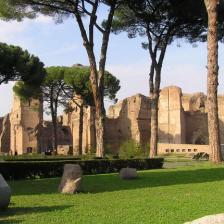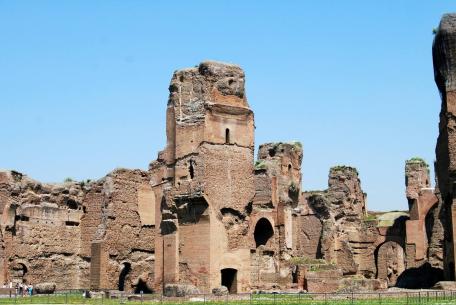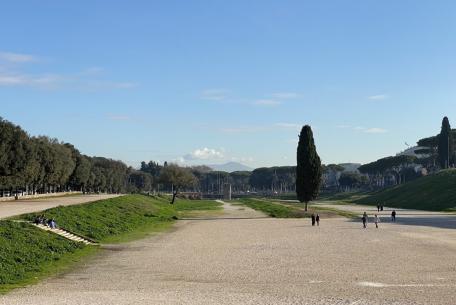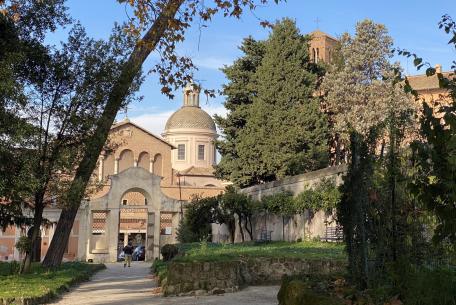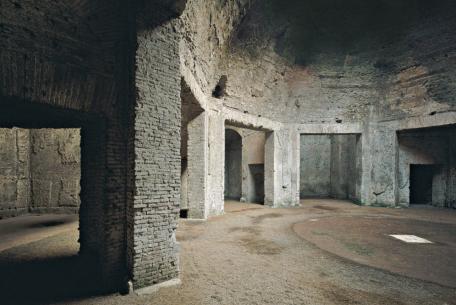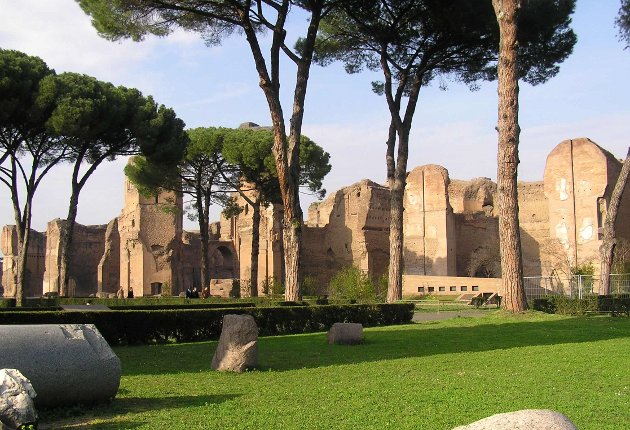
Our walk starts at the Baths of Caracalla, one of the largest and best preserved thermal complexes of antiquity. Extraordinary testimony of the grandeur of the emperors, the Baths were built at the behest of the Emperor Caracalla on the Piccolo Aventino between 212 and 216 AD, in an area near the first stretch of the Appian Way. Inaugurated in 217 AD. by Antonino Caracalla, from which they took their name, they could accommodate up to 1600 people in hot and cold water baths, were equipped with every comfort, and sumptuously decorated – with oriental marbles, mosaics, stuccos and statues.
A short distance away, continue your discovery of the history of Ancient Rome, reaching the Circus Maximus, the largest building for public entertainment in antiquity and one of the largest of all time. It was the theatre of the races, the most popular competition for the Romans, together with the gladiator games. The aurighi of the chariots were the darlings of the people. The area also served as a place for city political, social and religious events, such as triumphs, processions and public executions. Today the Circus Maximus is the extraordinary stage of some of the most prestigious concerts hosted in the capital.
From here, you can easily walk to Villa Celimontana, an enchanting garden on the Celio hill, occupied in medieval times by vegetable gardens and vineyards. Quiet and rich in lush vegetation, on a sunny day, the park is the ideal place for outdoor breakfasts and walks among historical and archaeological remains from various periods, such as the neo-Gothic temple, the Egyptian obelisk of Ramses II, from the Temple of the Sun in Heliopolis, and the Renaissance Palazzetto Mattei, the seat of the Italian Geographic Society.
Continue to the majestic palace built by Nero after the fire that devastated Rome in 64 AD: the Domus Aurea. It was the largest and most luxurious of the imperial residences, extending from Palatine Hill to Oppian Hill and part of Mount Celio for about a square mile. Gardens, woods, pavilions and even an artificial lake: the complex was famous for its grandeur and the magnificence of the decorations of its rooms, embellished with statues, stuccos and paintings. Some pavilions of the Domus, later covered by the Baths of Trajan, came to light by chance in the Renaissance. It happened when some famous artists of the time - including Pinturicchio, Ghirlandaio, Raffaello and Giulio Romano - descended from above in those "caves", copying the decorative motifs that took the name of "grotesque".
Not to be missed is a visit to the Colosseum, the most famous monument in the world and symbol of Rome, part of the Parco Archeologico del Colosseo with the Roman Forum and the Palatine Hill. The imposing structure has always been considered indestructible: according to a popular Roman tradition, "as long as the Colosseum lasts, Rome will also last." Its construction began in 70 AD with the emperor Titus Flavius Vespasian and ended in 80 AD under the empire of Titus, son of Vespasian.The amphitheatre was intended for fighting, simulations of hunting wild and exotic animals (venationes) and games between gladiators (munera) and is still today the largest one in the world. Its grandeur will leave you amazed: spread over 24,000 square meters, it could accommodate about 50,000 spectators. In its evocative basements, a maze of corridors, galleries and passages, there was an extraordinary "backstage" where the preparations for the most incredible show machine of the past took place.
 Condividi
Condividi












































